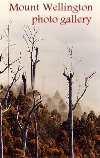
Winter: the Wellington RangeA low magnetic hum, beyond hearing. I sense it around the Mountain, and sense it more keenly when I am alone. Back here where people do not come, it is deep and strange, and it seems impossible that the tourist road is only an hour or two away. It is a place of low, brown and tough grass; bulging, voluptuous green cushion-plants , the glossy, snow-rimed spikes of Pandanis; chill, brilliant streams, damp and rotting fallen logs, slimy and delicious to the touch. There are vast surreal cities of grey and monolithic dolerite boulders, bearded with ice, green moss and orange lichen. There are forests of white coral: skeletal snow-gums killed decades ago by fire, now they are frozen moments of bone lightning, forking upwards from the mountain, telegraphing its endless hum to the snowy sky. It is silent, and when snow looms in grey acres, crossing and swallowing the emptiness of Thark Ridge, or coccooning the bleak crags of Collin�s Bonnet the silence itself is deadened and hushed. Once in July I felt the mountain noticing me. There is a wide, empty plain of creeks and button-grass which leads to Mount Connection. As I approached it from within a patch of scrub and low gums I felt ancient eyes all around me. I had met the thinking of the mountain, or the thinking thing that roams across it. For a long time it regarded me, then it went on. In those minutes the low hum was almost a shout. One other time it found me unexpectedly, on a full-moon evening among the great, pale boulders, and I had to leave, quickly. Great grandfather was a ranger on the mountain, hauling huge blocks of ice down an insanely steep mudslide of a trail on his acrobatic horse. Grandfather talks about years between the wars when he camped up there for days at a time. For my part I lived five damp years in the dark green womb of Fern Tree, snuggled against the mountain�s side, soothed by the fierce night wind which wrenched trees apart, and hearing, even in my sleep, the humming in the silence. |